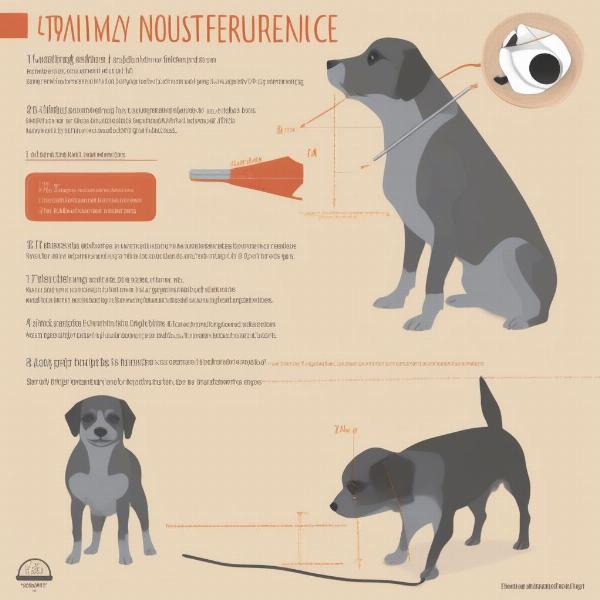Small muzzles for dogs are often necessary for a variety of reasons, from vet visits and grooming appointments to managing aggression or preventing scavenging. Choosing the right muzzle for your small breed dog can be challenging, but it’s crucial for their comfort and safety. This guide will explore the different types of muzzles available for small dogs, how to choose the right one, and tips for proper fitting and acclimation.
Types of Muzzles for Small Dogs
Several muzzle types cater to small breeds. Each offers different levels of restriction and comfort:
- Basket Muzzles: These are the most common and generally recommended type. They allow for panting, drinking, and even treat-taking, ensuring your dog stays comfortable. basket muzzle for small dogs are ideal for longer-term use.
- Soft Muzzles: Made from nylon or mesh, these offer less restriction but may not be suitable for dogs prone to biting. They’re better suited for short-term use, like vet visits.
- Short-Snouted Muzzles: Designed for brachycephalic breeds like Pugs and French Bulldogs, these muzzles provide adequate ventilation while accommodating their unique facial structure.
Choosing the Right Small Muzzle for Your Dog
Selecting the right small muzzle for dogs involves considering several factors:
- Breed and Size: Measure your dog’s snout circumference and length to ensure a proper fit. Even within small breeds, sizes can vary significantly.
- Purpose: A soft muzzle might suffice for grooming, while a basket muzzle is essential for managing aggression.
- Material: Opt for durable, non-toxic materials that are easy to clean.
- Comfort: Ensure the muzzle allows for panting, drinking, and some movement of the jaw.
 Measuring a Dog for a Muzzle
Measuring a Dog for a Muzzle
Fitting and Acclimation
Introducing a muzzle should be a positive experience. Start by letting your dog sniff and investigate the muzzle. Gradually associate the muzzle with positive experiences, like treats and praise. Never force the muzzle onto your dog.
- Gradual Introduction: Allow your dog to get used to the muzzle in short intervals, gradually increasing the duration.
- Positive Reinforcement: Reward your dog with treats and praise when they accept the muzzle calmly.
- Proper Fit: Ensure the muzzle is snug but not too tight, allowing for panting and drinking. muzzles for small dogs should always prioritize comfort.
“A properly fitted muzzle should allow a dog to pant, drink, and take treats, ensuring their comfort and well-being,” says Dr. Emily Carter, a certified veterinary behaviorist.
Common Concerns About Muzzles
Many owners worry about their dog’s comfort and the perception of using a muzzle. However, a properly fitted and introduced muzzle can be a humane and effective tool.
- Overheating: Basket muzzles allow for panting, preventing overheating.
- Stress: With proper acclimation, a muzzle can actually reduce stress in certain situations. dog muzzle for small dogs can provide a sense of security for anxious dogs.
- Negative Perception: Educate others that a muzzle is a safety precaution, not a sign of aggression.
“Muzzles can be invaluable tools for managing various behavioral issues and ensuring everyone’s safety, including the dog’s,” adds Dr. Carter.
Conclusion
Small muzzles for dogs are essential tools for various situations. Choosing the right type, ensuring a proper fit, and gradual acclimation are crucial for your dog’s comfort and safety. Remember, a muzzle can be a humane and effective way to manage behavior and protect both your dog and others. figure 8 leads for dogs can also be a useful tool in conjunction with a muzzle for added control.
FAQ
- Can my dog drink water with a muzzle on? Yes, most basket muzzles allow for drinking.
- Are muzzles cruel? No, when used correctly, muzzles are not cruel. They can actually reduce stress and anxiety in some situations.
- How do I choose the right size muzzle for my small dog? Measure your dog’s snout circumference and length.
- How do I get my dog used to wearing a muzzle? Introduce the muzzle gradually and use positive reinforcement.
- What type of muzzle is best for a short-snouted dog? Short-snouted muzzles are specifically designed for brachycephalic breeds.
- Can I leave my dog alone while wearing a muzzle? No, never leave a dog unattended while wearing a muzzle.
- How do I clean a dog muzzle? Follow the manufacturer’s instructions for cleaning.
ILM Dog is your global resource for expert dog care advice. We offer practical guidance on all aspects of dog ownership, from breed selection and training to health and nutrition. We specialize in providing breed-specific information and personalized advice to help you provide the best possible care for your canine companion. Need expert help? Contact us at [email protected] or call us at +44 20-3965-8624. ILM Dog is committed to helping you navigate the world of dog ownership with confidence.